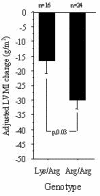Adipocyte-derived leucine aminopeptidase genotype and response to antihypertensive therapy
- PMID: 13678427
- PMCID: PMC212555
- DOI: 10.1186/1471-2261-3-11
Adipocyte-derived leucine aminopeptidase genotype and response to antihypertensive therapy
Abstract
Background: Adipocyte-derived leucine aminopeptidase (ALAP) is a recently identified member of the M1 family of zinc-metallopeptidases and is thought to play a role in blood pressure control through inactivation of angiotensin II and/or generation of bradykinin. The enzyme seems to be particularly abundant in the heart. Recently, the Arg528-encoding allele of the ALAP gene was shown to be associated with essential hypertension.
Methods: We evaluated the influence of this polymorphism on the change in left ventricular mass index in 90 patients with essential hypertension and echocardiographically diagnosed left ventricular hypertrophy, randomised in a double-blind study to receive treatment with either the angiotensin II type I receptor antagonist irbesartan or the beta1-adrenoceptor blocker atenolol for 48 weeks. Genyotyping was performed using minisequencing.
Results: After adjustment for potential covariates (blood pressure and left ventricular mass index at baseline, blood pressure change, age, sex, dose and added antihypertensive treatment), there was a marked difference between the Arg/Arg and Lys/Arg genotypes in patients treated with irbesartan; those with the Arg/Arg genotype responded on average with an almost two-fold greater regression of left ventricular mass index than patients with the Lys/Arg genotype (-30.1 g/m2 [3.6] vs -16.7 [4.5], p = 0.03).
Conclusions: The ALAP genotype seems to determine the degree of regression of left ventricular hypertrophy during antihypertensive treatment with the angiotensin II type I receptor antagonist irbesartan in patients with essential hypertension and left ventricular hypertrophy. This is the first report of a role for ALAP/aminopeptidases in left ventricular mass regulation, and suggests a new potential target for antihypertensive drugs.
Figures
References
-
- Koren MJ, Devereux RB, Casale PN, Savage DD, Laragh JH. Relation of left ventricular mass and geometry to morbidity and mortality in uncomplicated essential hypertension. Ann Intern Med. 1991;114:345–352. - PubMed
-
- Schillaci G, Verdecchia P, Porcellati C, Cuccurullo O, Cosco C, Perticone F. Continuous relation between left ventricular mass and cardiovascular risk in essential hypertension. Hypertension. 2000;35:580–586. - PubMed
-
- Levy D, Garrison RJ, Savage DD, Kannel WB, Castelli WP. Prognostic implications of echocardiographically determined left ventricular mass in the Framingham Heart Study. N Engl J Med. 1990;322:1561–1566. - PubMed
Publication types
MeSH terms
Substances
LinkOut - more resources
Full Text Sources
Other Literature Sources
Medical


